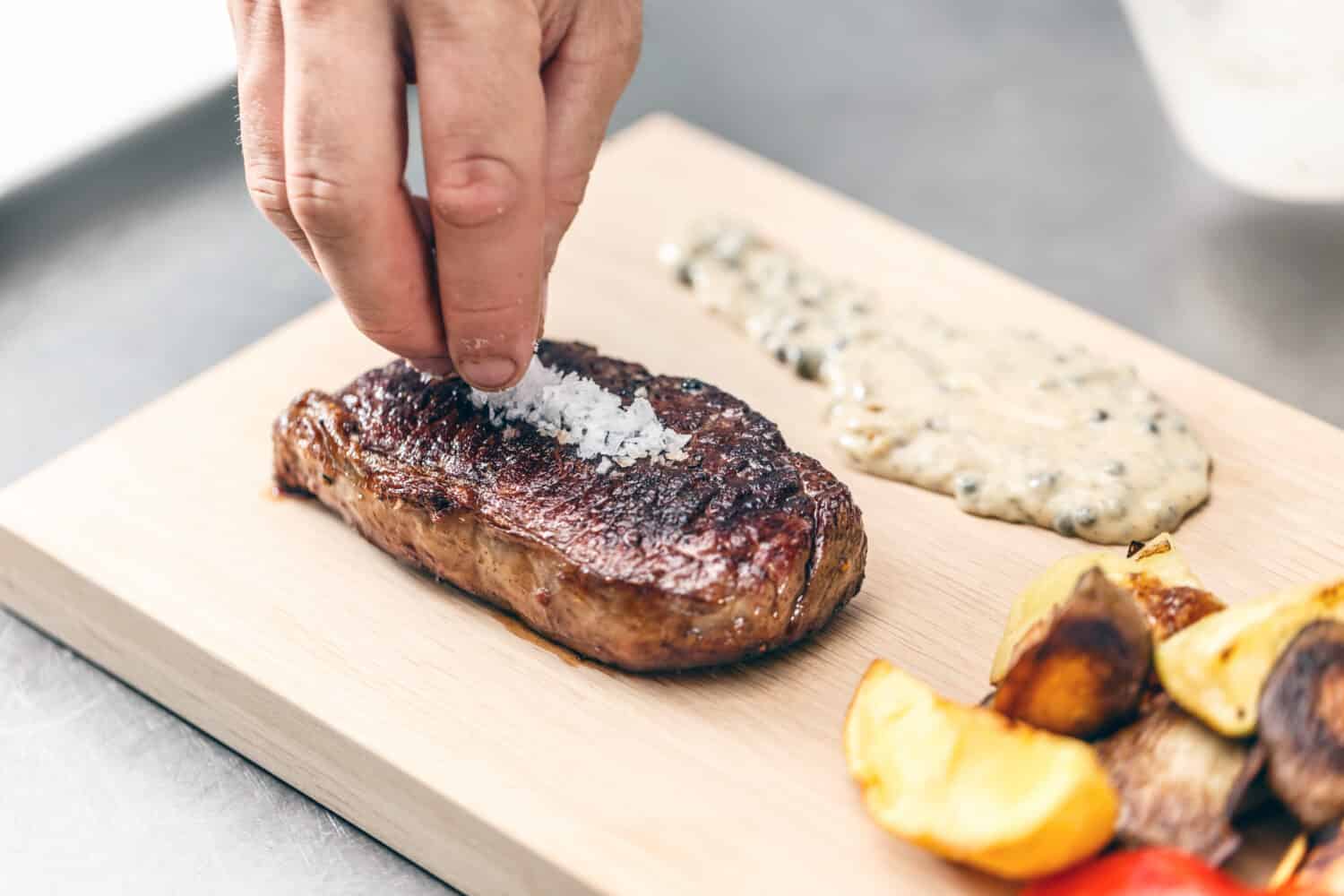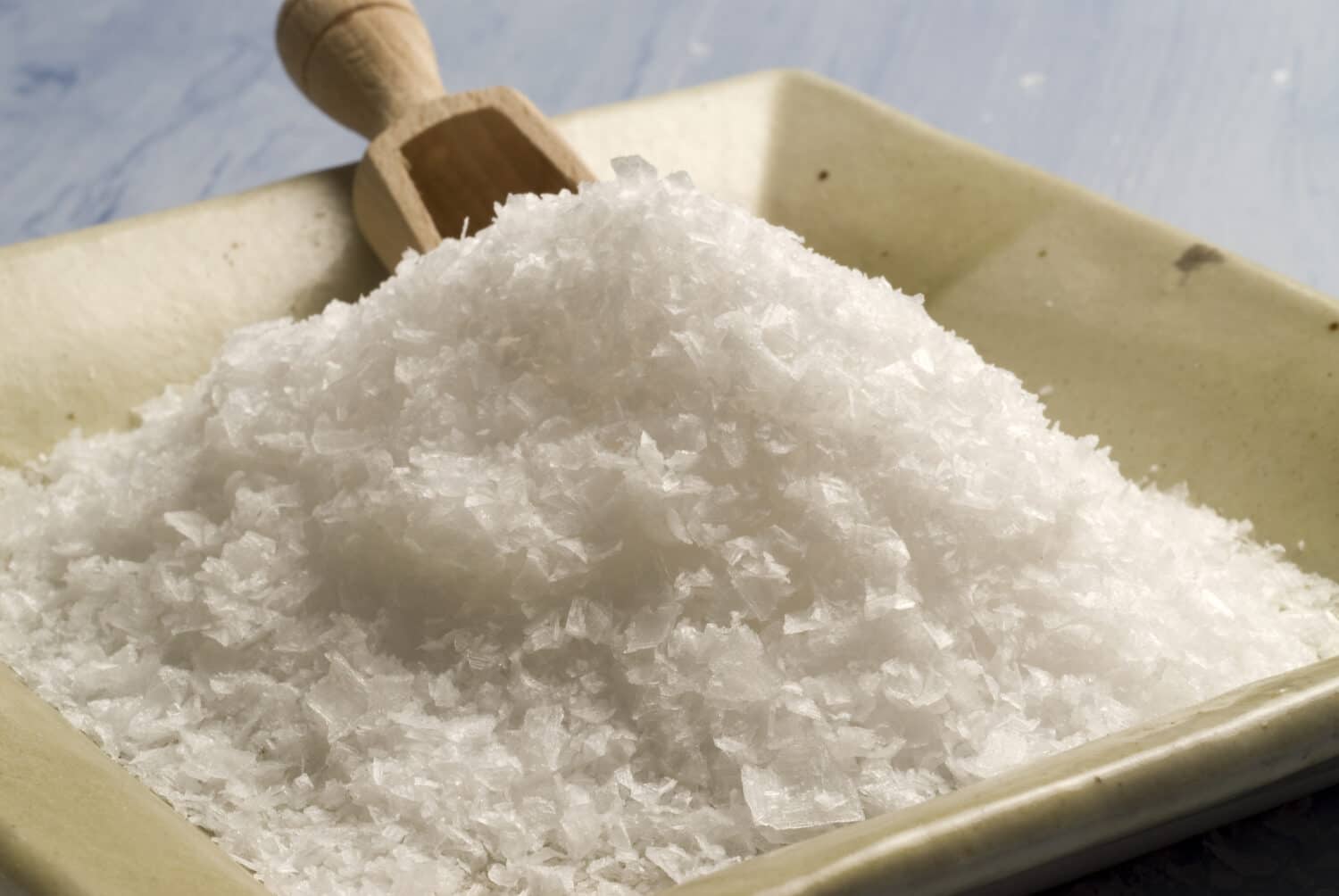You might think all salt is the same, but many cooks will tell you this is not true, especially when it comes to gourmet salts like Maldon and pyramid salts. Fancier than plain, old table salt, these two salts have more prominent and distinctly shaped flakes than other less costly salt types. However, they are not interchangeable premium salts. While similar, Maldon and pyramid salts differ in flavor, texture, and taste. Let us take a closer look at Maldon Salt vs. Pyramid Salt.
Maldon Salt vs. Pyramid Salt: What is Maldon Salt?
Produced by the Maldon Salt Company, founded in 1882, this premium salt is crafted through the traditional process of collecting seawater from the Blackwater Estuary in southeast England; the seawater is carefully evaporated, allowing delicate salt crystals to form at the surface. The salt is then hand-harvested with wooden rakes, preserving its distinct texture. After draining and drying, the salt has a pure, briny flavor.
Cooks love this salt because of its flakiness and less bitter taste than other salts. It is a pyramid-shaped salt that doesn't cake, making it a preferred finishing salt, particularly for grilled meat or baked goods like caramel cookies. Maldon salt is not typically used during cooking; it is best sprinkled over the dish when finished to add a subtle crunch to food. This crunch is due to the salt's unusually large flakes. The salt became sought after recently when celebrities like Jamie Oliver and Gwyneth Paltrow sang its praises.
Since Maldon salt is considered a high-end salt, expect to pay more for it. On average, a small 8.5-ounce box of Maldon salt costs anywhere from five to ten dollars, while larger bags can cost more. It is more expensive than table salt and other sea salts on the market.
Maldon Salt vs. Pyramid Salt: What is Pyramid Salt?
Another gourmet salt, pyramid salt, has unique pyramid-shaped crystals that distinguish it from regular table salt. Unlike Maldon salt, sourced in one place, pyramid salt is not specific to one geographic area. Pyramid salt comes from evaporated seawater, salt mines, or salt pans.
The process used to create pyramid-shaped crystals varies, but it usually involves controlled evaporation, where salt forms into its distinctive pyramid shapes as the water evaporates. Depending on its source, pyramid salt flavors vary widely. Typically, pyramid salt adds a hint of earthy flavor to dishes. Unlike Maldon salt, it can be used during cooking or simply as a finishing salt.
Pyramid salt tends to be on the higher end of the price range for gourmet salts. Prices vary, but a small container of pyramid salt ranges from five to twenty dollars for a few ounces or grams. The price depends on the brand, how it was produced, and where it came from.

©grafvision/Shutterstock.com
Maldon Salt vs. Pyramid Salt: Key Differences
Now that we have defined Maldon and pyramid salt let us examine their five key differences.
| Maldon Salt | Pyramid Salt | |
|---|---|---|
| Shape and Texture | Famous for its flaky texture, this salt is thin and delicate. | As the name suggests, the salt flakes are pyramid-shaped. The crystals are larger and coarser than Maldon salt. |
| Flavor | Maldon salt is popular because of its clean, pure briny flavor. Its saltiness is mild. It also doesn't have the mineral taste of other salts. | Pyramid salt's flavor varies widely, depending on where it is sourced. |
| Cooking Uses | Commonly used as a finishing salt, it appears on grilled meats, roasted vegetables, and salads. | Much more versatile than Maldon salt, this salt is used in cooking and as a finishing salt. |
| Cost | It is considered a premium salt and more expensive than other salts on the market. | While it also falls into the gourmet salt category, it is typically cheaper than Maldon salt. |
| Origins | This sea salt is produced in Maldon, England. | Pyramid salt is not tied to any geographic location. |
Maldon Salt vs. Pyramid Salt: Cooking Tips
Use Maldon salt to add extra flavor to ordinary dishes. Sprinkle a small amount over a green salad or add a pinch to eggs. It is especially good on fish dishes like pan-seared salmon. Additionally, try sprinkling Maldon salt over baked goods like chocolate chip or butterscotch cookies. The crystals are so large they are visible and won't dissolve into your cookies.
Like Maldon salt, pyramid salt is great spread on veggies and cookies. It can also be used when searing beef or to add texture to sea scallops. Consider adding it to a luxurious dark chocolate mousse.

©kmkillebrew/Shutterstock.com
In Summary
While both are categorized as premium sea salts, Maldon salt and pyramid salt differ in flavor, texture, and cooking use. They also come from different sources and means of production. While Maldon salt is produced in England, pyramid salt comes from many geographic regions and sources. With its delicate, flaky texture and mild, clean taste, Maldon salt enhances the natural flavors of dishes after cooking is complete. It also looks great on food, another reason it is a popular finishing salt.
Pyramid salt also looks great on food. Additionally, it is commonly used in cooking, unlike Maldon salt. During cooking, this salt gives dishes a hint of earthy mineral flavor. While many cooks swear by Maldon salt as a finishing salt, pyramid salt is less expensive and more versatile. Both salts are great additions to the family kitchen. Which one you use ultimately depends on your choice of dish, your personal taste preferences, and the family budget.
The image featured at the top of this post is ©Patty Orly/Shutterstock.com.

